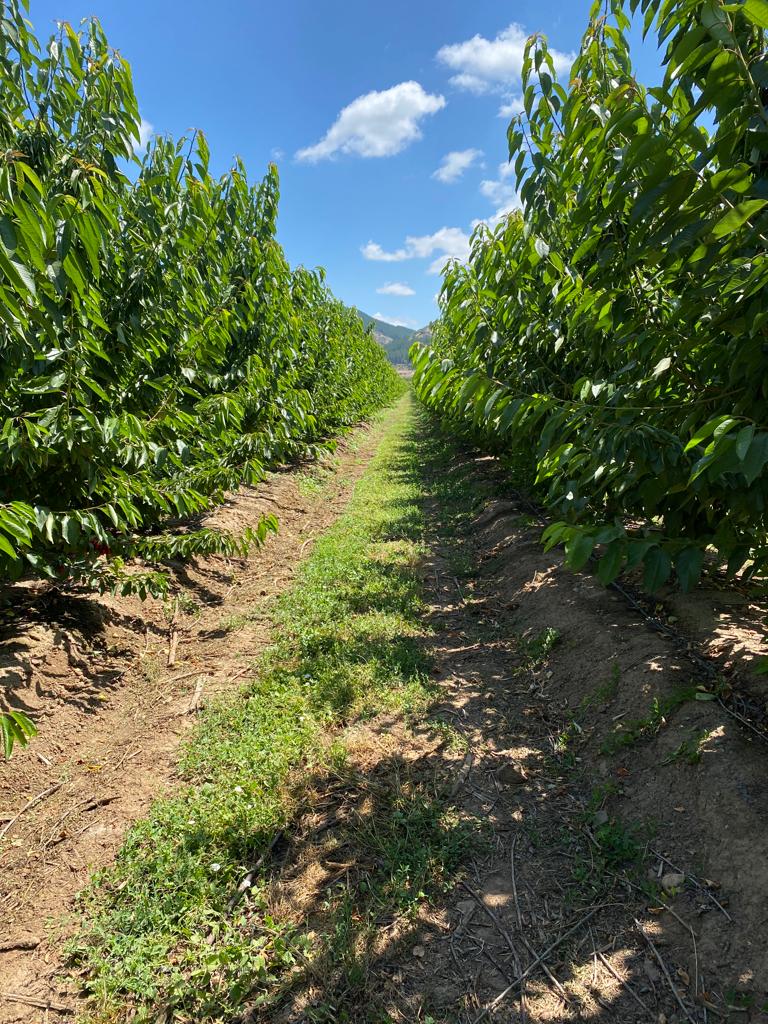Cherry orchards completely covered in snow in Argentine Patagonia, up to 40 centimetres of snow and up to 15 degrees below zero. This occurs mainly in the winter months of the southern hemisphere, but early snowfalls could also occur in autumn - April, May and June - and late snowfalls in spring. Smartcherry spoke about this phenomenon with Aníbal Caminiti, Manager of the Argentine Chamber of Integrated Cherry Producers (CAPCI).

"While the plants are dormant in winter, snow does not cause any major problems. The plants
Cherry trees are very resistant to low temperatures, they are naturally plants from regions
temperate and temperate-cold. The inconveniences occur mainly in two cases: when
The temperatures are extremely cold, and when snowfall and cold occur at times
that the vegetative organs begin to awaken and mobilize, as happens in spring."
When is there a higher chance of snowfall?
«Although the possibility of snow precipitation is concentrated in winter, it can spread and
These late snowfalls can occur when the plants already have developed vegetative organs, they are no longer dormant, they may have buds, they may have flowers. In this case, low temperatures are a problem, where the organs are sensitive and can freeze. In these cases, the control systems used in Argentine Patagonia are basically sprinkler or micro-sprinkler systems. However, if there are many centimetres of snow, it is not possible to carry out this frost control.
How do you manage a garden after snowfall?

«The management of the garden, in general, does not differ much from what happens when it rains. When it snows
or it rains you limit or suspend activities until you can resume them when the conditions
"The climate and environment allow it. The first thing is to clear the snow. More than snowfall, I would say that low temperatures are the most delicate issue. Here we can have temperatures of 15 degrees below zero, the usual is between 7 and 12 degrees below zero. When the ground freezes in winter, it limits earthmoving activities. For example, if I have to plant and the ground is frozen, it is not the ideal time and I have to suspend or postpone until the ground thaws or I have to plant earlier or later. If the first few centimetres of the surface freeze, it is broken up with a shovel or pickaxe and worked. If the ground freezes more, machinery is used to break up, to make trenches and allow winter work."
What happens if I plant in these conditions and then the ground freezes?
«The moisture that is in the ground freezes, then expands and when it returns to its normal state,
liquid causes the roots not to be in intimate contact with the soil particles. Therefore,
"You have to water to quickly generate this contact. Roots can also freeze. But ultimately the plants are resistant to snowfall and cold. Because the accumulation of snow can reach 40 centimetres or more, it covers all types of vegetation, so hares and rabbits, but mainly the hare in southern Patagonia, seek to feed and damage the stems that remain on the surface of the snow. So you have to intensify the control of hares. There are always protectors for hares, but when it snows they are covered by the snow."

What are the main variables to consider in these circumstances?
«Snow puts weight on the branches and can break them. If that snow freezes, it increases the risk of
weight and probability of breaking. Also, when we do frost control, the water in the
The spray can also freeze, which creates additional weight. Wind, which is a common condition in Patagonia, also generates various undesirable effects on the structure of the plants, on the formation of the plants and also on the breaking of branches. For this reason, cherry crops in Patagonia must necessarily be supported on wire structures, to be able to support the weight of the snowfall, the weight of frost control and to be able to mitigate the effect of the wind. All in order to be able to structure the plants well from a productive point of view.
What benefits do these climatic conditions provide for the fruit?
"As for the benefits, the snowfall itself does not generate any particular benefit, it does bring
temporary inconveniences, such as suspending and postponing all operational tasks: suspending the
pruning, soil work and plantations. The greatest benefit is not from the snow, but from the accumulation of cold hours. Patagonia and cold areas are guaranteed the cold hours that plants need to have good production. The Patagonian environment, in addition to being able to provide cold, also has much longer days during spring and especially summer. This makes the phenological stages slower and longer, which also has an impact on the final quality of the fruit. Just like the thermal amplitude, the thermal amplitude that occurs in Patagonia between day and night, means that the plant does not have to resort to its sugar reserves, which remain in greater concentration in the fruits and that gives it a higher level of sugars or Brix degrees.
Another benefit of an extremely cold environment like Patagonia is that it is a healthy environment from a health perspective, as there are almost no pests or diseases, so it creates a very interesting environment from that point of view.

What can you tell us about producing cherries under these conditions?
"There are many regions that produce with snow. It is the norm for productions in the hemisphere.
North: Canada, British Columbia, northeastern United States, Washington, Oregon, northern
Europe, parts of China. In many regions, cherries coexist with snow in winter. Naturally, cherries come from that side of the world, from a more temperate, temperate-cold area, although in recent years breeders have been developing varieties with fewer cold hour requirements, basically for commercial reasons, for market reasons, to be able to open the commercial offer to months where there is no cherry production, both in the northern hemisphere and in the southern hemisphere, in order to be able to supply those undersupplied windows. So varieties are generated that can be located in warmer areas, with less cold requirements. This is the trend we are heading towards. To give an example, varieties that are very well known to us such as Santina and Lapins, are originally from an experimental station in Summerland in British Columbia, Canada, areas where snow and cold are normal natural conditions.

Photo: Extending pipes for frost control.








